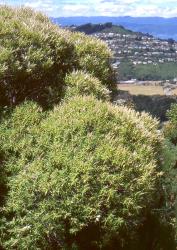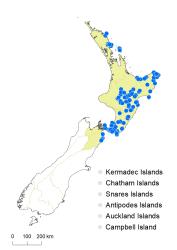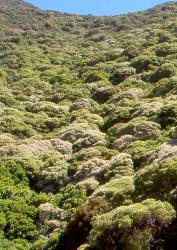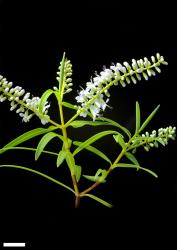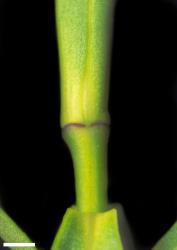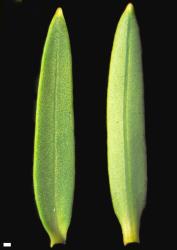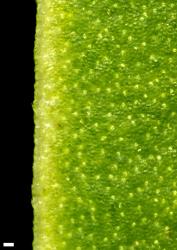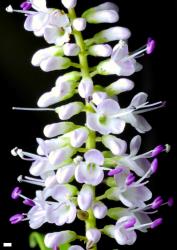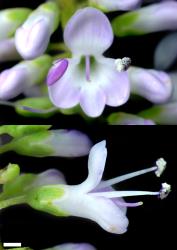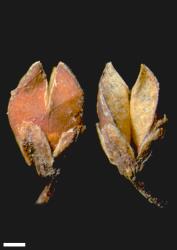- ≡ Hebe parviflora (Vahl) Andersen, Trans. New Zealand Inst. 56: 693 (1926)
- = Veronica arborea Buchanan, Trans. New Zealand Inst. 6: 242 (1874)
- ≡ Veronica parviflora var. arborea (Buchanan) Kirk, Trans. New Zealand Inst. 28: 527 (1896)
- ≡ Hebe parviflora var. arborea (Buchanan) L.B.Moore in Allan, Fl. New Zealand 1, 913 (1961)
Rounded, bushy, large shrub or small tree to 12 m tall. Stems erect, eglandular-pubescent or rarely glabrous; hairs usually bifarious, sometimes uniform. Leaf bud distinct, its leaves appressed until fully grown; sinus absent. Leaves opposite-decussate, erecto-patent to reflexed; lamina sub-coriaceous, linear to linear-lanceolate to narrowly oblong, 8–76 mm long, 1.5–7.0 mm wide, smaller and narrower in juvenile plants, dull pale green or green above, pale green beneath, midrib and sometimes two lateral veins evident; surfaces with eglandular hairs along midrib above and often minute glandular hairs beneath; margin minutely papillate or with short, tapering, antrorse hairs, entire; apex acute or plicate-acuminate, base cuneate; petiole indistinct, broadly winged, 1–3 mm long. Inflorescence a lateral raceme, 20–120 mm long; flowers crowded, 20–130, female or bisexual on separate plants, ⚥ ≥ ♀; bracts alternate, ovate to deltoid to oblong, < pedicels; pedicels erecto-patent to spreading, sometimes recurved in fruit, 0.3–4.0 mm long, glabrous or eglandular-hairy all around. Calyx lobes 4, obtuse to acute, 1.0–1.5 mm long, sub-equal, mixed glandular- and eglandular-ciliolate. Corolla 4–6 mm diameter; tube white, 2.0–3.8 mm long, > calyx, eglandular-hairy inside or with glandular hairs as well; lobes 4, white or tinged mauve or pink, spreading to recurved, unequal, elliptic to obovate to sub-orbicular, 2.5–3.0 mm long, obtuse or rounded; nectar guides absent. Stamen filaments white, 2.5–5.0 mm long; anthers magenta or purplish. Style glabrous, 3.5–6.0 mm long. Capsules latiseptate, sub-acute to obtuse, glabrous, 2.5–3.5 mm long, 1.4–2.5 mm at widest point. Seeds ellipsoid to discoid, flattened, smooth, straw-yellow to brown, 0.9–1.8 mm long.
Veronica parviflora is one of several very similar species that are characterised by narrow-linear to narrow-oblong leaves (Bayly et al. 2000).
Plants of V. parviflora and V. stenophylla differ from those of V. strictissima and V. traversii by their shorter capsules that are about twice the calyx. V. parviflora plants are often small trees (to 12 m tall), whereas plants of the other three species are shrubs, although sometimes up to 2.5 m tall. V. stenophylla plants differ from V. parviflora by having glabrous leaf margins, minute pits on the upper leaf surfaces, no or very few glandular hairs on the calyx lobe margins (and these usually with one terminal cell), and the corolla tube often longer than twice the calyx and usually glabrous inside. In V. stenophylla plants the leaves often curve backwards (i.e., away from the stem apex).
| parviflora | stenophylla | strictissima | traversii |
|---|---|---|---|---|
Habit | shrub or small tree up to 12 m tall | shrub to 2 m tall, sometimes sprawling | rounded shrub to 2 m tall | shrub to 2.5 m tall |
Leaf length (mm) | 8–76 | 16–87 | 9–49 | 16–44 |
Leaf width (mm) | 1.5–7.0 | 2.5–10.0 | 3.0–8.0 | 2.5–9.0 |
Leaf margin | minutely hairy | glabrous, or occasionally pubescent | glabrous, papillate, or with very short, antrorse, tapered, eglandular hairs | scabrous, ciliate or pubescent |
Leaf adaxial (upper) surface | smooth | minutely pitted, especially near margins; each pit with a minute glandular hair | smooth | smooth |
Calyx lobes | mixed eglandular- and glandular-ciliate; the glandular hairs with 2 terminal cells | usually eglandular-ciliate; if also glandular, the glandular hairs mostly with 1 terminal cell; hairs with 2 terminal cells rare | mixed eglandular- and glandular-ciliolate, sometimes sparsely so; the glandular hairs with 2 terminal cells | eglandular-ciliolate or mixed eglandular- and glandular-ciliolate; glandular hairs with 2 terminal cells |
Corolla tube | up to 2 × calyx; > corolla lobes | 2–4 × calyx; > corolla lobes | = or slightly > calyx; < corolla lobes | 3–4 × calyx; > corolla lobes |
Corolla tube | hairy inside | usually glabrous; sometimes hairy (especially var. hesperia from NW Nelson) | hairy inside | hairy inside |
Capsule | c. 2 × calyx | c. 2 × calyx | c. 3 × calyx | 3–4 × calyx |
Distribution | North Island, mostly in the east; South Island (coastal Marlborough only) | central and east North Island and outliers near Hamilton; South Island north of a line from Westport to Cape Campbell | South Island (Banks Peninsula only) | South Island (Marlborough, Canterbury south to Four Peaks Range (absent from Banks Peninsula) |
North Island: Northland (Russell, Whangārei, Hen & Chickens Is.), Auckland (Great Barrier I. [Aotea I.]), Volcanic Plateau (in the east and south), Gisborne, southern North Island.
South Island: Marlborough (coasts from Arapaoa I. south to Kekerengu).
Scrub, hillsides, streams and forest margins, frost hollows and flats, from near the coast to montane habitats, occasionally forming a canopy and dominating low forest or tall scrub. Recorded elevations range from 0 to 1067 m.
V. corriganii × parviflora is known from the central North Island.
Flowers: September–March, occasional throughout the year; fruits: January–June, persisting until November.
2n = 80 (see Bayly & Kellow 2006, as Hebe parviflora).
Veronica parviflora is classified in V. subg. Pseudoveronica sect. Hebe and the informal group “Occlusae” (Albach & Meudt 2010; Bayly & Kellow 2006).
V. parviflora is variable with respect to habit and leaf size. In Northland, the central North Island, and East Cape, plants are often large, rounded shrubs with leaves 40–70 mm long, whereas in Wellington and Marlborough they are more often trees, with leaves 25–40 mm long.
Young plants up to 1 m tall may be soft-branched shrubs, with small, linear leaves < 25 mm long, and slender branches. Only later does one stem become dominant and form a trunk, which can be up to 250 mm diameter or more.
Beever (1991) recorded koromiko tāranga and kōkōmuka tāranga as names in Māori for V. parviflora, but that species has since been revised (Bayly et al. 2000), and now it is unclear whether the name applies to V. parviflora, V. stenophylla, or both.



